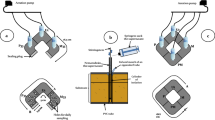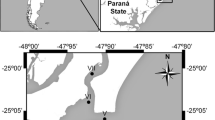Abstract
In this study, a microcosm experiment was conducted for 30 days to assess the impact of the presence of juvenile gray shrimp Crangon crangon on meiofauna. The results suggested that juvenile shrimp had a significant negative impact on the abundance of nematodes and copepods, but no effect on polychaetes. Moreover, nematodes showed a significant decline in individual weight. The collected nematodes were taxonomically identified and assigned to five functional traits: shapes of the tail and amphid, life history, feeding types, and adult length. The nematode traits were affected by the number of shrimp introduced, and descriptors followed normal or inversed bell-shaped curves. When no shrimp were present, the nematofauna had a higher species richness compared with treatments of 4, 8, and 12 shrimp. Bell-shaped curve patterns were common in relation to the two phases of feeding for C. crangon. During the first phase, C. crangon consumed the nematode species Oncholaimus campylocercoides; thereafter, shrimp fed mostly on the nematode Anticoma eberthi and copepods.







Similar content being viewed by others
Data availability
The datasets used and/or analyzed during the current study are available from the corresponding author on reasonable request.
References
Aller RC, Yingst JY (1985) Effects of marine deposit feeders Heteromastus filiformis (Polychaeta), Macoma balthica (Bivalvia) and Tellina texana (Bivalvia) on average sediment–solute transport, reaction rates and microbial distrinutions. J Mar Res 43:615–645
Allouche M, Nasri A, Harrath AH, Mansour L, Beyrem H, Bourioug M, Geret F, Boufahja F (2020) New protocols for the selection and rearing of Metoncholaimus pristiurus and the first evaluation of oxidative stress biomarkers in meiobenthic nematodes. Environ Poll 263:114529
Bell SS, Coull BC (1978) Field evidence that shrimp predation regulates meiofauna. Oecologia 35:141–148
Bezerra TN, Decraemer W, Eisendle-Flockner U, Hodda M, Holovachov O, Leduc D, Miljutin D, Mokievsky V, Pena Santiago R, Sharma J, Smol N, Tchesunov A, Enekey V, Zhao Z, Vanreusel A (2020) Nemys: world database of nematodes. Accessed at http://nemys.ugent.be
Bongers T, Alkemade R, Yeates GW (1991) Interpretation of disturbance-induced maturity decrease in marine nematode assemblages by means of the maturity index. Mar Ecol Prog Ser 76:135–142
Bongers T, de Goede RGM, Korthals GW, Yeates GW (1995) An update to the cprating of nematode genera can be found in proposed changes of c-p classification for nematodes. Russ J Nematol 3:61–62
Clarke KR (1993) Non-parametric multivariate analyses of changes in community structure. Aust J Ecol 18:117–143
Clarke KR, Gorley RN (2001) PRIMER v5: user manual/tutorial. PRIMER-E: Plymouth, UK 91p
Coull BC, Chandler GT (1992) Pollution and meiofauna: field, laboratory and mesocosm studies. Oceanogr Mar Biol 30:191–271
Essid N, Boufahja F, Beyrem H, Aïssa P, Mahmoudi E (2013) Effects of 17-α-estradiol on a free-living marine nematode community: a microcosm experiment. Afr J Aquat Sci 38(3):305–311
Essid N, Gharbi R, Harrath AH, Mansour L, Mahmoudi E, Beyrem H, Ansari KGMT, Boufahja F (2020) Toxicity of a chromium-enriched superfood, Spirulina platensis, assessed by taxonomic and morpho-functional diversity of marine meiofauna. Environ Poll 262:1143–1150
Federle TW, Livingston RJ, Meeter DA, White DC (1983) Modifications of estuarine sedimentary microbiota by exclusion of epibenthic predators. J Exp Mar Biol Ecol 73:81–94
Feller RJ, Coull BC (1995) Non-selective ingestion of meiobenthos by juvenile spot (Leiostomus xanthurus) (Pisces) and their daily ration. Vie Milieu 45:49–59
Gregg CS, Fleeger JW (1998) Grass shrimp Palaemonetes pugio predation on sediment- and stem-dwelling meiofauna: field and laboratory experiments. Mar Ecol Prog Ser 175:77–86
Gregg JC, Fleeger JW (1997) Importance of emerged and suspended meiofauna to the diet of the darter goby (Gobionellus bolesoma Jordan and Gilbert). J Exp Mar Biol Ecol 209:123–142
Hagerbaumer A, Hoss S, Heininger P, Traunspurger W (2015) Experimental studies with nematodes in ecotoxicology: an overview. J Nematol 47(1):11–27
Henry BA, Jenkins GP (1995) The impact of predation by the gridled goby, Nesogobius sp. 1 on abundances of meiofauna and small macrofauna. J Exp Mar Biol Ecol 191:223–238
Hussain MB, Laabir M, Daly Yahia MN (2020) A novel index based on planktonic copepod reproductive traits as a tool for marine ecotoxicology studies. Sci Total Environ 727:138621
Kotta J, Boucher G (2001) Interregional variation of freeliving nematode assemblages in tropical coral sands. Cah Biol Mar 42:315–326
McCall JN, Fleeger JW (1995) Predation by juvenile fish on hyperbenthic meiofauna: a review with data on post-larval Leiostomus xanthurus. Vie Milieu 45:61–73
Martin TH, Wright RA, Crowder LB (1989) Non-adaptive impact of blue crabs and spot on their prey assemblages. Ecology. 70:1935–1942
Moreno M, Semprucci F, Vezzulli L, Balsamo M, Fabiano M, Albertelli G (2011) The use of nematodes in assessing ecological quality status in the Mediterranean coastal ecosystems. Ecol Indic 11:328–336
Olafsson E, Elmgren R (1991) Effects of biological disturbance by benthic amphipods Monoporeira affinis on meiobenthic community structure: a laboratory approach. Mar Ecol Progr Ser 74:99–107
Palmer MA (1988) Epibenthic predators and marine meiofauna: separating predation, disturbance and hydrodynamic effects. Ecology 69:1251–1259
Platt HM, Warwick RM (1983) Free-living marine nematodes. Part I. British Enoploids. Cambridge University, London 307 p
Platt HM, Warwick RM (1988) Free-living marine nematodes. Part II. British Chromadorids. Synopsis of the British fauna (New Series). No. 38, E.J. Brill/W.Backhuys, Leiden
Probert PK (1984) Disturbance, sediment stability and trophic structure of soft-bottom assemblages. J Mar Res 42:893–921
Pihl L, Rosenberg R (1984) Food selection and consumption of the marine shrimp Crangon crangon in some shallow marine areas in western Sweden. Mar Ecol Prog Ser 15:159–168
Schratzberger M, Warwick RM (1999) Impact of predation and sediment disturbance by Carcinus maenas (L.) on free-living nematode community structure. J Exp Mar Biol Ecol 235:255–271
Schratzberger M, Warr K, Rogers SI (2007) Functional diversity of nematode communities in the southwestern North Sea. Mar Env Res 63(4):368–389
Seinhorst JW (1959) A rapid method for the transfer of nematodes from fixative to anhydrous glycerine. Nematologica 4:67–69
Semprucci F, Balsamo M (2012) Key role of free-living nematodes in the marine ecosystem. In: Boeri F, Jordan AC (eds) Nematodes: morphology, functions and management strategies. NOVA Science Publishers, Inc., Hauppauge, NY, pp 109–134
Semprucci F, Cesaroni L, Guidi L, Balsamo M (2018) Do the morphological and functional traits of free-living marine nematodes mirror taxonomicalal diversity? Mar Env Res 135:114–122
Taylor DL, Peck MA (2004) Daily energy requirements and trophic positioning of the sand shrimp Crangon septemspinosa. Mar Bio 145:167–177
Thistle D, Lambshead PJD, Sherman KM (1995) Nematode tail-shape groups respond to environmental differences in the deep-sea. Vie Milieu 45:107–115
Van Gestel CAM, Loureiro S, Zidar P (2018) Terrestrial isopods as model organisms in soil ecotoxicology: a review. In: Hornung E, Taiti S, Szlavecz K (Eds) Isopods in a changing world. ZooKeys 801:127–162
Vanaverbeke J, Martinez AP, Dahms HU, Schminke HK (1997) The metazoan meiobenthos along a depth gradient in the Arctic Laptev sea with special attentions to nematode communities. Polar Biol 18:391–401
Vitiello P, Dinet A (1979) Définition et échantillonnage du méiobenthos. Rapp. Comm. Int Expl Sci Mer Médit 25:279–283
Warwick RM, Price R (1979) Ecological and metabolic studies on free-living nematodes from an estuarine mud-flat. Estuar Coast Mar Sci 9:257–271
Warwick RM, Gee JM, Berge JA, Ambrose W (1986) Effects of the feeding activity of the polychaete Streblosoma bairdi (Malmgren) on meiofaunal abundance and community structure. Sarsia 71:11–16
Warwick RM, Clarke KR, Gee JM (1990) The effect of disturbance by soldier crabs Mictyris platycheles H. Milne Edwards on meiobenthic community structure. J Exp Mar Biol Ecol 135:19–33
Warwick RM, Platt HM, Somerfield PJ (1998) Free-living marine nematodes. Part III. British monohysterids. Synopsis of British fauna (new series) No. 53, Field Studies Council, Shrewsbury
Wieser W (1953) Die Beziehung zwischen Mundhöhlengestalt, Ernäh rungsweiseund Vorkommen bei freilebenden marinen Nematoden. Arkiv. För. Zoology 2:439–484
Wieser W (1960) Benthic studies in Buzzards Bay. II. The meiofauna. Limnol Oceanogr 5:121–137
Acknowledgements
The authors extend their appreciation to the Researchers Supporting Project number (RSP-2020/17), King Saud University (Riyadh, Saudi Arabia).
Funding
The authors extend their appreciation to the Researchers Supporting Project number (RSP-2020/17), King Saud University (Riyadh, Saudi Arabia).
Author information
Authors and Affiliations
Contributions
Mohamed Allouche: Formal analysis, validation, writing (original draft), and writing (review and editing). Ahmed Nasri: Data curation and investigation. Abdel Halim Harrath: Funding acquisition, writing (review and editing). Lamjed Mansour: Funding acquisition, writing (review and editing). Saleh Alwasel: Funding acquisition and investigation. Hamouda Beyrem: Data curation and investigation. Gabriel Plăvan: Investigation. Melissa Rohal-Lupher: Writing (review and editing). Fehmi Boufahja: Conceptualization, formal analysis, funding acquisition, investigation, methodology, supervision, validation, and writing (review and editing).
Corresponding author
Ethics declarations
Competing interests
The authors declare that they have no conflict of interest.
Ethical approval
Not applicable.
Consent to participate
Informed consent was obtained from all individual participants included in the study.
Consent to publish
Not applicable.
Disclaimer
This manuscript represents the views of the authors, and not those of the Texas Water Development Board.
Additional information
Responsible Editor: Vedula VSS Sarma
Publisher’s note
Springer Nature remains neutral with regard to jurisdictional claims in published maps and institutional affiliations.
Rights and permissions
About this article
Cite this article
Allouche, M., Nasri, A., Harrath, A.H. et al. Do presence of gray shrimp Crangon crangon larvae influence meiobenthic features? Assessment with a focus on traits of nematodes. Environ Sci Pollut Res 28, 21303–21313 (2021). https://doi.org/10.1007/s11356-020-12069-0
Received:
Accepted:
Published:
Issue Date:
DOI: https://doi.org/10.1007/s11356-020-12069-0




